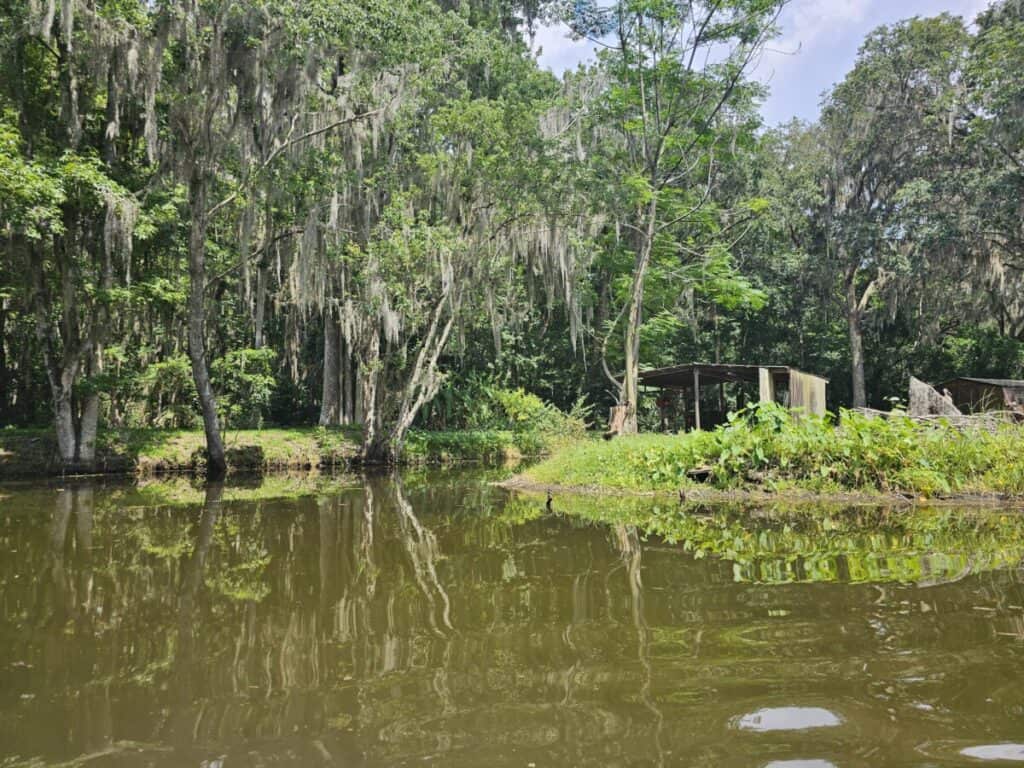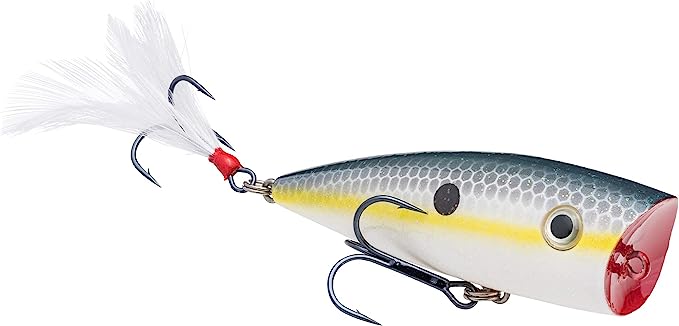
I consider myself a shallow water guy. Fishing for bass in shallow waters can be a gripping and rewarding endeavor. A key part of this thrilling pursuit is selecting the right lures. The correct lure can dramatically increase your success rate, transforming a good fishing trip into a great one.
What is Shallow Water Bass Fishing?
Shallow water bass fishing is an angling technique where anglers target bass in waters typically less than 10 feet deep (source). The definition of “shallow” varies based on the size of the body of water, the average depth of the body of water, and the specific habits of bass in the local ecosystem.
Shallow water bass fishing is favored for its accessibility, allowing anglers to fish from the shoreline, a boat, or even wading into the water. Shallow waters offer plenty of vegetation, rocks, wood, and man-made cover that serve as excellent hideouts for fish, making it a hotspot targeting the object of our fishing affection: BASS.
Why Shallow Water Bass Fishing is Unique
Do bass like shallow or deep water? It’s a debate that has been a hot topic of late with the advent of high tech graphs. However, shallow water bass fishing is unique because it allows anglers to observe bass behavior more directly and thus react more precisely. It’s a thrilling, action-packed fishing experience, often involving sight fishing where you can see bass in live-action stalking and attacking prey.
The shallows provide more visible cover than deep water, presenting unique challenges and opportunities for strategic fishing. I love to cast at cover that I can see and target bass that make their homes in the shallow waters because of the tangible and visual rewards associated with the thrill of the hunt for fish.
Professional bass fisherman John Cox eloquently describes the allure of shallow water bass fishing:
“… if I’m up shallow, seeing fish swimming, seeing turtles. I got so much stuff catching my attention, keeping me focused, I just really like it.”
Source
The Role of Lures in Shallow Water Bass Fishing
Lures play a vital role in shallow-water bass fishing. Lures that can navigate through or around cover, like squarebill crankbaits or Texas-rigged soft plastics, are popular choices. Depending on the time of day, season, and water conditions, different types of lures, such as topwater lures, spinnerbaits, jigs, and swimbaits, can all be highly effective for shallow-water bass fishing. Mastering their use and selecting the right lure is crucial to provoke strikes and catch trophy bass.
For a few targetted, shallow water tips, check out tips 2, 12, and 13 and more in 49 Bass Fishing Tips that Always Seem to Work.
A Deep Dive into the World of Bass Fishing Lures
A fishing lure can be a game-changer. A well-selected and well-used lure can deceive the most elusive fish, tricking it into seeing an artificial presentation as its next meal. Understanding different types of lures, their design, and how to use them can significantly increase your chances of landing bass in shallow waters.
Shallow water bass fishing lures are crafted to imitate the natural prey of bass. These lures are designed to operate optimally in the upper levels of the water column, making them perfect for skinny water fishing.
So, let’s explore the top 15 shallow water lures for bass fishing without further ado.
Top 15 Shallow Water Lures for Bass Fishing
This carefully curated list features the top 15 lures guaranteed to entice bass and boost your fishing success. From versatile crankbaits to irresistible topwater plugs, these lures are specifically designed for shallow water conditions.
Sure, here’s a table that simplifies the information in the provided content:
| Lure Type | Ideal Conditions | Ideal Locations | Tips for Use |
|---|---|---|---|
| Buzzbaits | Dawn, dusk, overcast days | Shallow waters, around cover (grass, logs, rocks) | Cast close to potential bass hideout and start retrieving immediately |
| Poppers | Early morning, evening | Shallow waters, around various cover (grass beds, weed lines, logs) | Cast near cover, let sit until ripples clear, give sharp pop on rod |
| Walking Baits | Early morning, late afternoon | Around points, flats, open water | Use rhythmic twitching retrieve to make zigzag |
| Hollow Body Frogs | Early mornings, evenings | Heavy cover areas (lily pads, grass mats, weeds) | Cast onto a lily pad or grass mat, retrieve with short, twitching motions |
| Toads | Early morning, late evening | Around weed lines, lily pads, grass flats | Cast near target area, reel back with steady retrieve |
| Prop Baits | Early morning, late evening | Calm, clear water. Near shallow cover | Cast close to cover, let rest until ripples disappear, retrieve with short sharp twitches. Vary cadence |
| Soft Plastic Jerkbait | Pre-spawn and post-spawn periods | Around cover, open water, over grass, stumpfields | Cast, let sink, retrieve with series of jerks and pauses |
| Swim Jigs | Pre-spawn period | Areas with heavy cover (grass, weeds, timber, lily pads) | Cast beyond target, retrieve with steady, swimming motion |
| Spinnerbaits | Good throughout the year. Great in the Fall when bass are chasing bait. | Around cover (timber, grass, under docks), muddy or stained water. | Cast towards target, retrieve at steady speed. Vary retrieval speed |
| Bladed Jigs | Early morning, late evening. Great choice for windy days. | Excellent in stained or muddy water. One of the best in grass flats. | Cast, let sink to desired depth, retrieve with steady reel |
| Squarebills | Late spring, summer | Shallow waters with heavy cover (timber, rocks) | Cast to target, retrieve steadily, allowing to bounce off structures |
| Texas Rig | Year-round bait. | Shallow to deep waters, around heavy cover | Cast around target areas, experiment with different retrieval speeds. Slow retreiveal usually works best |
| Weightless Presentations | Clear water | Shallow water areas with sparse cover | Cast towards target, let fall on slack line, watch line for any twitch or movement |
| Jigs and Flipping Baits | Pre-spawn period | Around heavy cover (grass, matted vegetation, timber, docks, lily pads) | Cast beyond target, use series of hops and pauses (for jigs), flip/pitch into heavy cover (for flipping baits) |
| Swimbaits | Pre-spawn, post-spawn periods | Clear water | Cast and retrieve steadily or use “jerk and pause” retrieval |
1.  Buzzbaits
Buzzbaits
Unveiling the Buzzbaits: A Quick Overview
Buzzbaits are topwater lures that create a distinctive buzzing sound and splash that grabs the attention of bass. Their spinning, propeller-like blade disturbs the water surface, generating noise and ripples that stimulate fish into action. These are particularly effective as shallow water bass baits, especially in low-light conditions. Check out the Booyah brand on Amazon.
Ideal Conditions for Using Buzzbaits
Buzzbaits are best used during dawn, dusk, or overcast days when bass are more likely to be in shallow waters. They are also highly effective around cover such as grass, logs, and rocks.
I’m a big fan of using a buzzbait to cover water quickly. I often use them to identify higher concentrations of fish; then, I’ll slow down to pick apart that area once I’ve marked it as one of particular interest. In addition to the benefit of covering water efficiently, there’s almost nothing like the adrenaline rush created by a bass exploding on a buzzbait. Buzzbait fishing is not for the faint of heart!
How to Fish with Buzzbaits: Simple Steps for Success
When fishing with buzzbaits, cast the lure close to potential bass hideouts such as grass, logs, or rocks. After casting, start retrieving immediately to keep the buzzbait on the surface. Vary the retrieval speed and occasionally pause or twitch to increase the lure’s attractiveness.
2.  Poppers
Poppers
Poppers Exposed: What Makes Them a Favorite Among Anglers
Poppers are topwater lures with a dished face. When twitched, they splash water and create a popping sound that mimics an injured baitfish on the water’s surface. This noise can prove irresistible to bass in shallow waters, particularly around cover.
When and Where to Use Poppers
Poppers prove most effective when bass are actively feeding on the surface. Ideal times to use poppers include the early morning and evening. They work well around grass beds, weed lines, docks, and logs.
Tips to Perfect Your Popper Fishing Technique
Cast your popper near cover, and once it lands, let it sit until the ripples clear. Then, snap your rod to create a splash or pop. Pause for a few seconds and then repeat. Alternatively, you can work the popper quicking to imitate fleeing prey. The idea is to mimic a wounded baitfish, so try different rhythms until you find what works best.
There are a ton of great popper options, but one of my favorites is made by Strike King (Amazon).
3. Walking Baits
Introducing Walking Baits: A Secret Weapon in Shallow Waters
Walking baits are surface lures that you ‘walk’ across the water using a technique known as “walking the dog.” These lures zig-zag across the water, creating a trail that bass find irresistible.
Timing and Locations for Walking Baits
Walking baits work well when bass are feeding on baitfish near the surface. Early morning and late afternoon are typically the best times to use these lures. They are also great for fishing around points, flats, and open water.
How to Maximize Your Catch with Walking Baits
To use a walking bait, cast it out and then use a rhythmic twitching retrieve to make it zigzag across the surface of the water. Keep slack in your line as you retrieve, and vary your speed to see what bass best respond to.

4. Hollow Body Frogs
Spotlight on Hollow Body Frogs: Lures that Leap
Hollow-body frogs are topwater lures that float on the surface and mimic the movement of wounded prey. Their weedless design makes them perfect for fishing in heavy cover without getting snagged.
The Perfect Scenario for Hollow Body Frogs
These lures are best used in heavy-cover areas like lily pads, grass mats, and weeds. Hollow-body frogs can be effective throughout the day but are particularly useful during early mornings and evenings. They can also be used during high sun by targeting shade (under bushes, overhanging trees, docks, etc.)
Top Techniques for Fishing with Hollow Body Frogs
Cast your frog onto a lily pad, grass mat, or just past your target area, and reel it in with short, twitching motions. Many people find success by working frogs extremely slowly with long pauses between movements. When a bass strikes, wait for a second or two before setting the hook to ensure the fish has taken the frog.
Where I live in Florida, frogs are a staple almost every time of the year. I almost always have one tied on and on the deck, ready to go.
5. Toads
Meet the Toads: An Unconventional yet Effective Lure
Toad lures are soft-bodied topwater baits that create a lot of disturbance on the water’s surface. Their soft bodies collapse when a bass bites, ensuring a good hook set.
When and Where to Use Toads for Optimal Results
Toads are highly effective around weed lines, lily pads, topped-out vegetation, and grass flats. They can be used throughout the day, but early morning and late evening are typically the best times to use toad lures.
How to Fish Using Toads: An Angler’s Guide
Cast the toad lure near the target area and reel it back with a steady retrieve. Its flapping legs will create a commotion on the water’s surface, attracting bass. If a bass strikes, wait until you feel the weight of the fish before setting the hook.
6. Prop Baits
Prop Baits Unleashed: Making Waves in Shallow Water Fishing
Prop baits are topwater lures with one or two propellers. They churn the water during the retrieve, creating a disturbance that mimics struggling prey. Their noise and action can prove irresistible to predatory bass.
The Best Conditions and Locations for Prop Baits
Prop baits are best used in calm, clear water where they can create a noticeable disturbance on top of the water. They are effective around almost any shallow cover, especially in the early morning or late evening.
Mastering the Art of Fishing with Prop Baits
Cast the prop bait close to cover, and let it rest until the ripples disappear. Then, retrieve it in a series of short and sharp twitches, allowing pauses in between. The propellers will churn the water, creating a splash and bubbles that mimic a distressed baitfish.
7.  Soft Plastic Jerkbait (Flukes)
Soft Plastic Jerkbait (Flukes)
Understanding Soft Plastic Jerkbait: A Versatile Choice
Soft plastic jerkbaits are versatile lures that mimic the movement of baitfish. Their soft body and lifelike design make them a potent weapon for skinny water anglers. I’m a fan of Zoom’s Flukes (Amazon) for their durability and life-like action.
Optimal Conditions for Using Soft Plastic Jerkbait
These lures work well in various conditions and environments. You can use them around almost any form of cover and in open water.
Techniques for Effective Fishing with Soft Plastic Jerkbait
Cast the lure and let it sink. Then, retrieve it with a series of jerks and pauses. Also, try working soft plastic jerkbaits on or near the top of the water. The erratic motion mimics an injured baitfish, enticing the bass to strike. Experiment with the speed and rhythm of your retrieve to find what works best.
Flukes are one of my favorite shallow water baits for bass because they are incredibly versatile and almost impossible to hang up. I can cast them virtually anywhere.
Pro Angler and Guide Ron Riyals is a big fan of fluke fishing. Check out this great read on the Power of the Fluke.
8. Swim Jigs
Swim Jigs: The Lure that Swims to Success
Swim jigs are retrieved to create a swimming action through fluid reeling. Their design allows them to move through heavy cover without getting snagged, making them ideal for shallow water.
Ideal Scenarios for Swim Jigs
Swim jigs excel in areas with heavy cover, like grass, weeds, and timber. They can be used at any time of the day but are especially effective during the pre-spawn period when bass are feeding aggressively. Swim jigs are also excellent for spawning periods as they mimic bream attacking bass beds in search of food.
Tips for Fishing with Swim Jigs
Cast the swim jig beyond your target area and retrieve it with a steady swimming motion. I like to add a soft plastic trailer to enhance the lure’s movement in the water. If you encounter cover, don’t stop too long, but pause the swim jig at the cover to entice bass.
9. Spinnerbaits
The Spin on Spinnerbaits: A Lure Worth Its Weight in Bass
Spinnerbaits are unique lures with a weighted head, a wire arm, and one or more spinning blades. The spinning blades create flash and vibration in the water, attracting bass from a distance. J3’s Modular Spinnerbait System is one of a kind. Their patented design sets them apart from the competition. I love the way I can tailor the lure to different conditions. Words can’t do it justice. Check out the video above for a great explanation of this unique spinnerbait.
I met the founders a few years ago and am continually impressed with their products as well as the character of their company. Check ’em out and support this great lure company.
When and Where to Use Spinnerbaits
Spinnerbaits are versatile and can be used in a variety of conditions. They’re particularly effective around cover like timber, grass, and under docks. Muddy or stained water is ideal for these lures as the vibration and flash can attract bass that may not see other more subtle presentations. Check out this article for full details on when to use a spinnerbait.
How to Fish with Spinnerbaits: Angler’s Insights
Cast the spinnerbait towards your target area and retrieve it at a steady speed. You can vary the depth by letting it sink before you start your retrieve or by reeling faster or slower. The key is experimenting with different speeds and depths until you find what works.
10. Bladed Jigs
Bladed Jigs: The Talk of the Bass Fishing World
Chatterbaits, or bladed jigs, are a combination of a jig and a spinnerbait. They produce a vibrating action and flash that can be highly attractive to bass. Once again, J3 comes through with an incredible product. Bar none, the best bladed jig I’ve ever used is the Depth Charge. It’s different than anything on the market, featuring a pivot body and interchangeable bladed.
The Perfect Time and Place for Bladed Jigs
Bladed Jigs excel in stained or muddy water and around heavy cover. They can be used at any time, but the prime times are the early morning or late evening, when bass are most active. I prefer a decent chop (caused by wind) for the best chatterbait bite.
How to Use Bladed Jigs for Maximum Bass Capture
Cast your bladed jig and let it sink to your desired depth. Then, retrieve it with a steady reel. The blade on the jig head will move back and forth, creating vibration and flash that bass can’t resist. Don’t hesitate to experiment with different retrieval speeds and rhythmic rod twitches to enhance the lure’s action.
11. Squarebills
Squarebills Explained: A Lure with an Edge
Squarebill crankbaits are shallow water lures known for their square lip, which causes them to swim and bounce off structures without getting snagged.
Optimal Conditions for Fishing with Squarebills
These lures excel in shallow waters with heavy cover such as timber and rocks. The warmer months, particularly late spring and summer, are some of the best times to use squarebills when bass feed in the shallows.
The Right Technique to Fish with Squarebills
Cast the squarebill to your target area and retrieve it steadily, allowing it to swim and bounce off structures. The erratic movement mimics a wounded baitfish, which elicits a reaction strike.
12. Texas Rig
An Introduction to Texas Rig: A Classic Lure for Shallow Waters
The Texas Rig, a soft plastic lure rigged with a bullet weight, is a classic lure used in bass fishing. It’s versatile, weedless, and excellent for fishing around heavy cover.
When and Where to Deploy the Texas Rig
The Texas Rig can be used in various conditions, from shallow to deep waters and around all sorts of cover. It’s particularly effective during the summer months when bass hide in heavy cover to escape the heat.
Bass Fishing Hall of Famer Doug Hannon was a big proponent of Texas Rig fishing. Doug certain knew something about bass fishing,
By the mid-’80s, Hannon had caught and released over 500 bass weighing 10 pounds or more …
Source
Texas Rig Fishing Techniques Every Angler Should Know
Slide the bullet weight onto your line, then tie on your hook. Insert the hook into the top of the bait, then back out about a quarter of an inch below the head. Push the bait up and rotate it, then insert the hook point into the body of the bait for a weedless setup. Cast your rigged bait around your target areas and experiment with different retrieval speeds.
I grew up in Central Florida. The Texas rig is the number one go-to bait here and for a good reason. I have seven trophy catches alone on the Texas rig, including a 10-plus and a giant 13.5-pounder. Fish them SLOW in Florida for the best results.
Insider Tip
Before your next Florida bass fishing trip, check out our list of the Top 21 Places to Fish for Bass in Florida.
13. Weightless Presentations
Weightless Presentations: Light as a Feather, Catch in All Weather
Weightless presentations involve fishing soft plastic baits without any added weight. The result is a natural, slow-falling lure that can be highly enticing to bass.
The Ideal Conditions for Using Weightless Presentations
Weightless presentations are effective predominantly in clear to lightly stained water, where the natural, slow fall of the lure can attract bass from afar. They’re also great in shallow water areas with sparse cover.
Techniques for Successful Fishing with Weightless Presentations
Cast your weightless rig towards your target and let it fall on a slack line. Watch your line for any twitch or movement, as a bass bite can be subtle. Periodically twitch your rod tip to give the lure a more lifelike action.
14. Jigs and Flipping Baits
Jigs and Flipping Baits: A Double Threat in Shallow Water Bass Fishing
Jigs and flipping baits are excellent for targeting bass in shallow water. Jigs are designed to mimic various prey. Flipping baits can get into the heaviest cover where bass hide, especially in high sun.
Ideal Scenarios for Jigs and Flipping Baits
These lures excel around heavy cover, like grass, timber, docks, or lily pads. They can be used at any time of the year, but they’re particularly effective during periods of extreme or high heat periods.
Mastering the Use of Jigs and Flipping Baits: A Guide for Anglers
For jigs and flipping baits, pitch or flip to your target. Quiet entry is crucial to your success. Let it sink to the bottom, and then use a series of hops and pauses to imitate prey.
Jigs and flipping baits are known to catch BIG bass. If you’re looking for the highest concentration of big fish in a lake, check out our post How Do You Find the Biggest Bass in a Lake?
15. Swimbaits
The Swimbaits Phenomenon: An Effective Lure for Shallow Waters
Swimbaits are realistic, versatile lures that mimic the look and movement of baitfish. They come in various sizes and styles, from soft plastics to hard-bodied lures.
The Perfect Time and Place for Swimbaits
Swimbaits can be used year-round, but they’re especially effective during the pre-spawn and post-spawn periods when bass are actively feeding. They’re an excellent way to cover water, and their realistic appearance can fool even the most cautious bass.
How to Fish with Swimbaits: Techniques for Success
Depending on the type of swimbait you’re using, you can either cast and retrieve it steadily or use a “jerk and pause” retrieval to mimic an injured baitfish. When using larger swimbaits, remember to give bass a little extra time to swallow the lure before setting the hook.
Insider Tip
Choose shallow water moving baits for early morning or late evening bass. In general, bass are out away from cover looking to feed during low light periods of the day. When the sun is high, opt for slower presentations. Here’s some great info on what to use for early morning bass fishing.
Troubleshooting Common Issues in Shallow Water Bass Fishing
Shallow water bass fishing can be rewarding, but it’s not without its challenges. Here are some common issues that anglers face and tips to overcome them:
1. Snagged Lures: This is one of the most common issues when fishing in shallow water due to the presence of submerged logs, rocks, and dense vegetation.
Solution: Use weedless lures or lures designed to bounce off cover without getting snagged. Adjust the retrieval speed and angle to minimize snags. Periodically check your lures for debris and exposed hooks.
2. Spooking the Fish: In shallow water, bass can be easily spooked by sudden movements and noise.
Solution: Be as stealthy as possible. Use a quiet approach, wear colors that blend with the surroundings, and make long, accurate casts to keep your distance.
3. Ineffective Lure Action: Sometimes, a lure doesn’t work as expected due to improper rigging or retrieval.
Solution: Ensure your lures are rigged correctly and experiment with different retrieval speeds. Observe the lure’s action in clear water before using it.
4. Bass not Biting: There are days when bass seem to ignore all your lures.
Solution: Experiment with different lure sizes, colors, and actions. Adjust your fishing time, target different locations, or switch to live bait if regulations allow.
Remember, patience and perseverance are crucial in bass fishing. Keep honing your skills and knowledge, and you’ll overcome these common issues and enjoy productive shallow-water bass fishing.
Frequently Asked Questions
1. What makes a good shallow-water bass fishing lure?
A good shallow-water bass fishing lure is one that effectively imitates local prey. It should move and look like the small fish, insects, or other prey that bass feed on in your fishing area. The lure should also be suited for navigating the types of cover found in shallow waters, such as weeds, lily pads, fallen trees, and rocks. Bass love to hide and ambush prey in these areas, so lures that can wiggle through these spots without getting snagged are key.
Additionally, the lure should match the current water conditions. For example, you might opt for a lure that includes significant contrast in darker, murkier waters. Conversely, a more natural, subdued color pattern may be more successful in fooling wary bass in clear waters.
2. How do I choose between different shallow water bass fishing lures?
Choosing between different types of lures depends on a combination of factors. The type of cover you’re fishing around is one of the primary considerations. For example, if you’re fishing around a lot of weeds, you might choose a weedless frog. If fishing in open water with little cover, you could opt for a spinnerbait or swimbait.
Water temperature and clarity are other important factors. Certain lures work better in different conditions. For example, topwater lures can be effective in calmer conditions, while a chatterbait rig might be more effective in windy conditions. Additionally, try to match your lure to the species and size of the local baitfish, which is the concept of “match the hatch” in fishing, and it can drastically improve your success. Read more on matching the hatch in Tip 1 of 49 Bass Fishing Tips that Always Seem to Work.
3. What are the best times to fish for bass in shallow waters?
The best times to fish for bass in shallow waters are typically early in the morning and late in the evening. During these times, bass are most active and often hunt for food in the shallows. These are also the periods of the day when the light levels change dramatically, which can trigger bass to feed.
In terms of seasons, bass tend to move into the shallows during the spring for spawning, making this a great time to target them. Similarly, during fall, bass often move into shallow water to feed and prepare for winter. In the hot summer months, bass will often be in the shallows early in the morning (What Do You Use for Early Morning Bass Fishing?) and late in the evening when temperatures are cooler. During the winter, they might venture into the shallows on warmer, sunny days when the shallow water can be significantly warmer than the deeper parts of the lake.
Insider Tip: Flooding
When water levels are high because of recent rain or flooding, head to the bank. High water levels push fish to the shallows in search of food. Flooding or other high water conditions are prime time for a great shallow water bite!
Final Cast
Shallow water bass fishing offers an adrenaline-filled experience that’s hard to match. It requires a keen understanding of bass behavior, local conditions, and the right lures. Whether it’s the buzzing action of a buzzbait, the subtle twitch of a soft plastic jerkbait, or the lifelike swimming motion of a swimbait, every lure in your box has a time and place.
Understanding how and when to use each of these “Top 15 Shallow Water Bass Fishing Lures” is the key to unlocking a successful day on the water. Now, it’s time to cast a line and get your fish on! Go get ‘em!




